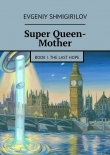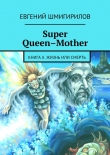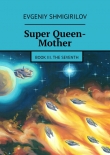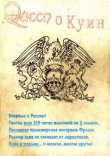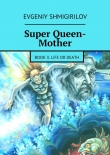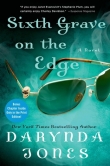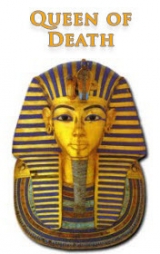
Текст книги "Queen of Death"
Автор книги: John Milne
Жанры:
Прочая старинная литература
,сообщить о нарушении
Текущая страница: 1 (всего у книги 3 страниц)
CHAPTER ONE
Holiday in London
It is hot in Cairo in August – very hot. The people who live in Cairo go away in August if they can. Some go to Alexandria, where it is much cooler, and some of the lucky ones go abroad to Europe or America.
Salahadin El Nur, Chief Inspector in the Egyptian Police, was one of the lucky ones. He was able to go on holiday because no archeologists come to Egypt in August when it is so hot. Archeologists prefer to come to Egypt in the cooler months of winter.
It is hot in Cairo in August, but it is much hotter in the south of Egypt! In the desert around Luxor, the sun can burn a man's body like a bar of red-hot iron. And it is there that most of the archeologists want to work. Many of the ancient temples and cities of Egypt are in and around the modern town of Luxor.
Thursday, 4th August, was Salahadin's last day at work. He was going on holiday for three weeks. His assistant, Inspector Leila Osman, would be in charge while Salahadin was away. At half past eleven, Salahadin tidied up his papers and locked the drawers of his desk. Then he stood up and went over to where Leila was sitting. He gave her the keys.
Leila, like Salahadin, was a graduate of Cairo University. They had both studied Ancient History. Leila was twenty-seven, six years younger than Salahadin. She had joined his department five years ago and was now one of the youngest inspectors in the Egyptian police.
'I'm off to London on Saturday,' Salahadin told Leila. 'I'm staying there for three weeks and I'll be back again on Saturday 27th.'
'And I'll have a holiday here in the office!' replied Leila.
'There'll be nothing for me to do. I'll read the newspapers and count the days until you get back. Don't forget to send me a postcard from Piccadilly.'
'Why Piccadilly?' asked Salahadin.
'People say that Piccadilly is the centre of the criminal world,' was Leila's reply.
Salahadin laughed and hurried out of the office. He wanted to get a taxi before the lunchtime rush hour in Cairo began.
On Saturday, Salahadin arrived at Cairo International Airport early in the morning. It was already warm and everyone was getting ready for another day of burning heat. But the passengers were looking forward to going to Europe where it would be much cooler.
The customs and immigration officials knew Salahadin and he quickly passed through into the Departure Lounge. Soon he was in the plane and on his way to London.
In London, everything was very different. It was wet and cold. Salahadin arrived at his hotel in Gower Street just after three o'clock in the afternoon. It was a small hotel, but it was just round the corner from the British Museum. Salahadin was going to spend part of his holiday working in the Museum with a friend, Dr Peter Earl. The British Museum has one of the largest collections of Egyptian antiquities in the world.
On Saturday evening, it was still raining a little, but it was warmer. Salahadin went for a walk through the streets of Central London. He walked down Tottenham Court Road to Leicester Square and then along to Piccadilly. When he was in Piccadilly, he remembered Leila's postcard.
I'll buy it now while I remember, thought Salahadin. He walked into a tourist shop selling postcards and books. Salahadin walked past the bookshelves to find a postcard. He found one which was a photograph of "Piccadilly By Night". He walked back to the counter to pay for it. On his way back, he had a quick look at the books on the shelves. He noticed a book which interested him. The title of the book was The Mystery of Queen Axtarte and the name of the author was Dr John Farrow.
Salahadin knew that Queen Axtarte was a queen in Ancient Egypt. And Salahadin had read many books on Ancient Egypt written by famous archeologists. But he had never heard of an archeologist called Dr Farrow.
Salahadin decided to buy the book and read it later. He paid for the postcard and the book and walked out into the busy streets of Piccadilly. It was now raining heavily. Salahadin walked towards Leicester Square. He noticed that a new film was being shown in one of the cinemas. Salahadin decided that was the best way to spend a wet evening in London. He had a meal in a small restaurant and went into the cinema.
It was very late when Salahadin got back to his hotel. He went to bed and soon fell asleep. The Mystery of Queen Axtarte lay on the table beside his bed. It was still wrapped up in the paper from the bookshop.
CHAPTER TWO
Who is Dr Farrow?
When Salahadin was having breakfast the next morning, he was called to the telephone. It was his friend, Dr Earl.
'Welcome back to London,' said Dr Earl. 'My wife and I want to know if you'd like to lunch with us today?'
'Yes, I'd like that. Thanks very much. I'll get a train from Waterloo and I'll be at your house by twelve.'
Peter Earl lived in Richmond, a suburb of London. Salahadin knew it well – he had been there many times before.
After breakfast, Salahadin had some time to wait before starting out on his journey to Richmond.
He remembered the book he had bought the night before. He unwrapped it and read what was written on the back cover.
Salahadin started to read the book, but soon it was time to leave for his train to Richmond.
THE MYSTERY OF QUEEN AXTARTE
Dr John Farrow
Dr Farrow's research provides new answers to some of the many questions about Queen Axtarte. These questions have puzzled archeologists for many years:
* Who was Queen Axtarte?
* What was the Curse of Queen Axtarte?
* Why was she called the Queen of Death?
Dr Farrow also gives his answer to the most important question:
* Where was Queen Axtarte buried?
In Dr Peter Earl's sitting-room, Salahadin looked out across the street to the Richmond park. He watched an old man with his dog.
'An Englishman and his dog,' said Salahadin. 'I've never been able to understand the English and their love of dogs.'
'And you Egyptians, my friend,' replied Peter Earl, 'what about your cats? Your ancestors – the Ancient Egyptians – loved cats, didn't they?'
They both laughed.
'Talking of Ancient Egyptians reminds me of something,' said Salahadin. 'I found a new book in a bookshop in Piccadilly last night. It's written by a man called Farrow – Dr John Farrow. Have you heard of him?'
'Dr John Farrow – now that is strange. I was going to ask you about him. Have you read this morning's papers?'
Peter Earl handed Salahadin a copy of The Sunday Times.
'There's a report on page three that puzzles me,' went on Peter Earl.
Salahadin opened the paper at page three and found the report near the bottom of the page.
The Tomb of the Queen of Death
Dr John Farrow, the young archeologist who claims to have discovered the secret burial place of Queen Axtarte – flew with his wife to Cairo last Thursday. Dr Farrow has studied the writing on an ancient stone pillar kept in the British Museum. The pillar was brought to Britain many years ago. It was found in the ancient temple of Karnak, which is a few kilometres north of Luxor in Upper Egypt.
Dr Farrow believes that the writing was made by someone who was at Queen Axtarte's burial. That person lived for only a few hours after the burial, but lived long enough to write down where she was buried. Dr Farrow is going to Luxor to find the tomb and to prove that his claims are correct.
'This pillar from the Temple of Karnak . . .' Salahadin began. 'Is there really such a pillar in the Museum?'
'Yes, there is. And it's got some marks on it which might be writing. But no one is certain.'
'It seems that Dr John Farrow is certain,' said Salahadin.
'Who is Dr Farrow? Why haven't I heard his name before?' Peter Earl told Salahadin what he knew about Dr Farrow.
'Farrow is about twenty-eight years old. He was a brilliant student at Cambridge. One of the best there has ever been. But after he got his doctorate, he changed completely. He left Cambridge about three years ago and went to live with some friends in Wales. He didn't write any letters. He didn't tell anyone about his visits to the British Museum and his interest in the pillar from Karnak. He has written this book and now he has gone off to Cairo.'
'And his wife has gone with him,' said Salahadin.
'I didn't even know that he was married,' said Peter Earl.
'And he's never been to Egypt before,' went on Salahadin. 'He doesn't know how hot it is. It's too hot to search for a tomb near Luxor at this time of the year.'
'Yes, he's not going to find it easy.'
'Who else knows about the writing on this pillar?' asked Salahadin.
'The man who knows most about it is your friend, Professor Gomouchian. And he's in Cairo.'
'Perhaps I ought to be in Cairo too,' said Salahadin slowly and thoughtfully. 'Many people would like to know where the tomb of Queen Axtarte is. And I'm not speaking about scholars and archeologists. I'm thinking of smugglers like the Amsterdam Ring.'
'Yes, you could be right,' Peter Earl agreed. 'The Amsterdam Ring would like to know where the Queen of Death is buried. The treasure in her tomb will be worth millions of pounds.'
'And here is a report in The Sunday Times, where everyone can read about it,' said Salahadin.
The two men sat silently for a few moments.
'I'll be late coming to the Museum tomorrow,' said Salahadin. 'I'll have to go to our Embassy and get in touch with my assistant, Leila Osman.'
CHAPTER THREE
Salahadin is Suspicious
Early next morning, Salahadin was at the doors of the Egyptian Embassy in London. It was not long before he had sent off a telex to the Ministry of the Interior in Cairo and another telex to his assistant, Leila Osman.
The first telex was to his friend, Chief Inspector Ahmed Abbas. Salahadin had worked with Inspector Ahmed before.
The telex said:
ATTENTION: INSPECTOR AHMED ABBAS
MINISTRY OF INTERIOR/CAIRO
DR JOHN FARROW AND WIFE REPORTED ARRIVING IN CAIRO LAST THURSDAY. PLEASE CONFIRM ARRIVAL AND INFORM ME NAME OF THEIR HOTEL.
SALAHADIN EL NUR EGYPTIAN EMBASSY/LONDON
The second telex, to Leila Osman, said:
ATTENTION: INSPECTOR LEILA OSMAN
ANTIQUITIES PROTECTION DEPARTMENT/CAIRO
DR JOHN FARROW (ARCHEOLOGIST) REPORTED ARRIVING IN CAIRO LAST THURSDAY. PLEASE INFORM ME OF HIS PLANS AND MOVEMENTS.
SALAHADIN EL NUR EGYPTIAN EMBASSY/LONDON
Then Salahadin went to the Visa Section of the Embassy and looked at the Visa Applications. He soon found Farrow's application. Salahadin noticed a number of unusual things about the application.
Now this is interesting, thought Salahadin. He has left out his doctorate and he says he's a school teacher. Very strange. And why does he say he's going to Egypt as a tourist?
Salahadin realized that Leila would know nothing about Dr Farrow. Farrow had not written on his visa application that he was an archeologist. His arrival in Cairo would not be reported to Salahadin's office.
The replies to his telex messages came in shortly after each other. Leila's telex confirmed what Salahadin had already guessed.
Good, thought Salahadin. She has got in touch immediately with Inspector Ahmed.
ATTENTION: "SALAHADIN EL NUR
EGYPTIAN EMBASSY/LONDON
NO ONE CALLED DR JOHN FARROW HAS REPORTED TO THIS OFFICE. NOTHING KNOWN OF HIS MOVEMENTS OR PLANS. HAVE REPORTED MATTER TO INSPECTOR AHMED.
LEILA OSMAN
The telex from Inspector Ahmed confirmed Salahadin's suspicions.
ATTENTION: SALAHADIN EL NUR
EGYPTIAN EMBASSY/LONDON
CONFIRM ARRIVAL OF MR JOHN FARROW AND HIS WIFE AS TOURISTS IN EGYPT. FARROW'S OCCUPATION GIVEN ON IMMIGRATION FORM AS SCHOOL TEACHER. FARROW AND WIFE STAYED ONE NIGHT – THURSDAY 4TH AUGUST HOTEL MIRABEL. LEFT FRIDAY WARNING. NO KNOWLEDGE OF WHERE THEY ARE NOW. TRYING TO FIND THEM. PLEASE EXPLAIN YOUR INTEREST IN FARROW.
AHMED ABBAS
It was two o'clock when Salahadin received the telex messages. It was too late to get a plane for Cairo that day. Also, Salahadin had some things to do in London. He wanted to find out as much as he could about Dr John Farrow from Peter Earl. And he wanted to know if Interpol – the International Police – had anything about the man on their files.
First, Salahadin booked a flight to Cairo for the following day. Then he sent off two further telex messages.
ATTENTION: INSPECTOR LEILA OSMAN
ANTIQUITIES PROTECTION DEPARTMENT/CAIRO
RETURNING CAIRO IMMEDIATELY. URGENT YOU MEET ME AT CAIRO AIRPORT TOMORROW – TUESDAY 9TH – FLIGHT MEA 435 FROM LONDON ARRIVING CAIRO 20.45.
SALAHADIN EL NUR
Second message:
ATTENTION: INSPECTOR AHMED ABBAS
MINISTRY OF INTERIOR/CAIRO
ARRIVING CAIRO TOMORROW TUESDAY 9TH – FLIGHT MEA 435 FROM LONDON ARRIVING CAIRO 20.45. URGENT YOU MEET ME. URGENT – REPEAT – URGENT YOU FIND FARROW AND WIFE. WILL EXPLAIN WHEN WE MEET.
SALAHADIN EL NUR
Salahadin thanked the officials in the Embassy and hurried out to get a taxi to the British Museum. As he sat in the taxi, Salahadin asked himself over and over again: Why had Farrow tried to deceive the Egyption officials by saying that he was a teacher and not an archeologist? And why had he said that he was in Egypt as a tourist? Farrow had written all these things in his visa application four weeks ago. But then he had told someone that he was going to Egypt to find the tomb of Queen Axtarte. He had told someone about this, because it had been reported in The Sunday Times.
Peter Earl had also been busy that morning. He had phoned up everyone who knew Dr Farrow. Everybody said that Farrow had left Cambridge and gone to live with some friends in Wales. But nobody seemed to know anything more. Someone had heard that Farrow was using drugs. Another had heard that Farrow had been in trouble with the police. But no one knew anything for certain.
Finally Peter Earl phoned up The Sunday Times and spoke to the reporter who had written about Farrow going to Cairo.
When Salahadin arrived at the British Museum, Peter told him about the calls he had made to Farrow's friends.
'I'm interested in the remark about drugs,' said Salahadin. 'The people who sell drugs in England often smuggle them from the Middle East. And the people who smuggle drugs sometimes smuggle antiquities. Perhaps Farrow is involved with a gang of smugglers.'
'You'd better ask Scotland Yard and Interpol,' suggested Peter Earl. 'They may know something more about Farrow.'
'That's what I'm going to do now,' said Salahadin. 'But first – a question which you can answer – do you believe that Farrow has discovered the burial place of Queen Axtarte?'
'Farrow was a brilliant student at Cambridge. He claims that he has discovered the Queen's burial place. It is possible that he is telling the truth.'
'And other people might agree with you,' said Salahadin. 'If Farrow is involved with a gang of smugglers, he might have told them how to find Queen Axtarte's tomb. I'm sure they would be interested in the treasure.'
'But why did Farrow phone up The Sunday Times?' Peter Earl asked.
'So that's how the report got in the newspaper,' said Salahadin.
'Yes, Farrow phoned up the paper and told them about his visit to Cairo. If Farrow is working with a gang, why would he do that?'
'Perhaps he is calling for help,' replied Salahadin. 'The smugglers may be making Farrow work with them. Perhaps Farrow doesn't want to help them to find the tomb.'
Salahadin promised to write to Peter and let him know what had happened. Then the two men said goodbye and Salahadin went to Scotland Yard.
Salahadin had arranged to meet Chief Inspector Beaston of Scotland Yard. The Chief Inspector showed Salahadin a file with a short report on Dr John Farrow. Farrow had been fined two years earlier for having a small quantity of cannabis.
'But he never told us where he got the cannabis,' Chief Inspector Beaston told Salahadin. 'If he had told us where he got the drugs, he would not have been fined.'
'What about Interpol?' asked Salahadin. 'Do they know anything about Farrow?'
'Nothing at all,' replied Chief Inspector Beaston. 'As far as we know, this visit to Egypt is the first time he has ever left England.'
'It's strange that no one knows very much about Dr Farrow,' said Salahadin.
It was late when Salahadin got to bed, but he read a little of Farrow's book before he fell asleep. And the next day on the plane he went on reading the book with interest.
I must go and see Professor Gomouchian early tomorrow morning, he thought to himself, as the plane took him across the Mediterranean towards Egypt.
CHAPTER FOUR
The Black Mercedes
Inspector Ahmed and Leila were waiting for Salahadin when his plane landed at Cairo International Airport. They had a police car and a driver with them. The driver set out immediately for the Ministry of the Interior in the centre of Cairo.
'Have you any news of Dr Farrow and his wife?' was Salahadin's first question.
'We have checked every hotel in Cairo,' replied Inspector Ahmed. 'We cannot find them at all.'
'What about Luxor?' asked Salahadin. 'Have you tried to find them in Luxor?'
'Why Luxor?' asked Ahmed.
Salahadin told Ahmed and Leila what he had learnt in London. And he told them about Dr Farrow's book, The Mystery of Queen Axtarte.
'In his book,' Salahadin explained, 'Farrow claims that the tomb of Queen Axtarte is near Luxor on the east bank of the Nile.'
'But all the tombs of the Pharoahs and the Queens of Egypt are on the west bank of the Nile,' interrupted Leila.
'Farrow explains that in his book,' replied Salahadin. 'Queen Axtarte knew that all the tombs were on the west bank. She was a very clever woman and that's why she had her tomb made on the east bank of the Nile.'
'And you think that Farrow has come here to Egypt to look for this tomb?' Inspector Ahmed asked Salahadin.
'I'm sure that's what he is doing,' replied Salahadin; 'And he's not alone.'
'Yes, his wife is with him,' agreed Leila.
'I don't mean his wife,' said Salahadin. 'I think there is a gang of smugglers with him.'
The car stopped at a big roundabout in Heliopolis – a modern suburb of Cairo. A large black Mercedes drew up beside them.
'Why do you think there's a gang with him?' asked Ahmed.
'I'll answer that question in a few moments,' replied Salahadin. 'First, I want to buy some cigarettes.'
'What do you want cigarettes for?' asked Leila. 'You don't smoke.'
Salahadin did not answer Leila's question. Instead, he spoke to the driver, 'Do you know that cigarette kiosk about two hundred metres on the right?'
The driver nodded his head to show that he understood.
'Stop in front of the kiosk,' Salahadin told the driver.
The car slowed down, moved over to the right and stopped by the pavement. Salahadin got out of the car and walked slowly over to the kiosk. He bought a packet of cigarettes and walked back to the car.
'Don't start yet,' Salahadin told the driver. He turned and spoke to Ahmed and Leila. 'Do you see that black Mercedes parked beside the pavement about twenty metres in front of us?'
They both looked at it carefully.
'It's got a foreign number plate,' said Inspector Ahmed.
'That's the one,' said Salahadin. 'Now watch what happens.'
The police car drove away from the side of the road. When they had driven past the Mercedes, the Mercedes moved away from the pavement and followed them.
'I noticed it earlier,' Salahadin told the others. 'I thought that car was following us. Now I am sure.'
They were approaching a busy road junction in the centre of Heliopolis. There were traffic lights ahead of them and a tram was coming up to the junction from the right. The lights in front of them were changing from green to red.
'Drive as fast as you can,' Salahadin told the driver. 'Get across before that tram comes.'
The driver put his foot on the accelerator18 and drove across the tramlines. The Mercedes tried to follow behind them. The tram driver rang his warning bell loudly. The tram brakes squealed as the tram tried to stop. But it was too late. The tram hit the back of the Mercedes and the car ran onto the grass. It stopped in the middle of the junction.
'Stop – quick,' shouted Salahadin.
The police driver stopped as quickly as he could. Salahadin, Ahmed and Leila jumped out of the car and ran back. But they were too late. Two men who had been in the car had jumped out. They had disappeared through the crowd of people who were running towards the accident.
'Too late,' said Ahmed. 'They've escaped.'
'Let's have a look inside the Mercedes,' said Salahadin.
Inspector Ahmed went up to a traffic policeman and showed him his identity card.
'Go and phone the police at the Ministry of the Interior,' Inspector Ahmed told the traffic policeman. 'Here's the telephone number. Tell them that Chief Inspector Ahmed Abbas is here.'
Ahmed and Leila kept the crowd away from the Mercedes while Salahadin searched through it.
Salahadin sat in the driver's seat of the Mercedes and looked around inside. He picked up a packet of cigars and a book which was lying on the back seat of the car. Then he looked in the boot which had sprung open in the crash with the tram. He found nothing else.
Two policemen arrived. Ahmed told them to keep the crowd away from the Mercedes and to wait for the police from the Ministry of the Interior.
'They'll tow the car away with them,' he explained to the policemen.
They walked back again to their own car.
'What did you find?' Leila and Ahmed asked together.
'A packet of cigars,' replied Salahadin. 'Dutch cigars.'
'So it is the Amsterdam Ring,' remarked Leila.
'Perhaps,' replied Salahadin. 'But whoever they are, they're involved with Farrow. Look!'
Salahadin held up the hook he had found in the Mercedes. It was The Mystery of Queen Axtarte by Dr John Farrow.
CHAPTER FIVE
Professor Gomouchian
Next morning, Salahadin phoned Professor Gomouchian and arranged to see him. He took a taxi to Zamalek, where Professor Gomouchian lived.
Professor Gomouchian lived on the top floor of a high block of flats. Salahadin got out of the lift on the top floor and rang the bell of the flat door. The door was opened by the Professor's housekeeper. The housekeeper knew Salahadin and showed him into the sitting-room. It was an unusual room, full of antiquities – stone pots, vases, and hundreds of small statues.
The blinds were drawn and it was rather dark in the room. Salahadin looked slowly round.
'Hello,' said a voice. It was Professor Gomouchian.
Professor Gomouchian was an old man – about eighty years old. He had a large head which was covered with long, white hair. He was sitting in a wheelchair and his legs were covered with a rug.
'It's been a long time since I last saw you,' said the Professor, wheeling his chair up to Salahadin. The two men shook hands and Salahadin looked round the room once again.
'You have your own museum here,' said Salahadin. 'It's always a pleasure to come and visit you and look at your collection of antiquities.'
'You don't come here for pleasure,' the Professor replied. 'When you come here, you want to find out something. What is it this time?'
'Have you heard of Dr John Farrow?' asked Salahadin.
'I've got his book here on my shelves,' replied the Professor, pointing to the bookshelves behind him.
'And have you read his ideas about Queen Axtarte and about where she was buried?'
'Yes, I have,' replied Professor Gomouchian. 'And I think he may be right.'
'I'm beginning to believe that he is right too,' said Salahadin.
'We know that Queen Axtarte was afraid of tomb robbers,' continued the Professor. 'It is possible that she had her tomb made on the east bank of the Nile because all the other tombs were on the west bank.'
'But what about all the slaves who dug her tomb?' asked Salahadin. 'And all the nobles who attended her funeral? Why did none of them ever tell the secret of her tomb?'
'The slaves were easy to deal with,' replied Professor Gomouchian. 'The Queen had them all killed.'
'And the nobles?'
'It was the custom to have a feast after a funeral in Ancient Egypt. The great feast after the funeral of Queen Axtarte was held in the Temple of Karnak. We know that before her death, the Queen ordered all the food to be poisoned . Everyone who attended her funeral had to attend the feast and eat the food. And they all died a terrible death.'
'And that explains the writing on the stone pillar from the Temple of Kamak,' added Salahadin.
'That is a possible explanation,' agreed the Professor. 'One of the mourners managed to write a message on a stone pillar before he died.'
'And the Curse of Queen Axtarte. What do you think about that?' asked Salahadin. 'Do you think she was trying to frighten away any tomb robbers? Or do you think she had another plan?'
Professor Gomouchian wheeled his chair up to the book-shelves and took down a copy of Farrow's book. He opened the book and read out the words which are known as the Curse of Queen Axtarte.
'I am Queen Axtarte – Queen of Queens. I shall live forever. These are my words: anyone who enters my tomb – anyone who steals from my tomb – anyone who touches my body – that person will die – that person will die a terrible death. And many more shall die with him."
'If you found the Queen's tomb, would you go into it and touch anything?' Salahadin asked the Professor.
'No, I would not,' was the immediate reply. 'I would want to have a lot of scientific tests done before I did anything at the tomb of Queen Axtarte.'
'But, why?'
The Professor took down another book from his bookshelves. It was called Poisons and Diseases in Ancient Egypt.
'The Ancient Egyptians knew much more about the world than we think,' he told Salahadin. 'They knew something about disease and about poisons. There were many great plagues in Ancient Egypt. It is possible that Queen Axtarte had the germs of a terrible disease put in her tomb.'
'So if anyone found the tomb, they might be in great danger?'
'If anyone found the tomb and went inside, they would be in great danger,' replied Professor Gomouchian.
'I must go to Luxor immediately,' said Salahadin. 'Can you show me where the tomb might be?'
The Professor wheeled his chair to where a large map of Ancient Egypt was hanging on the wall. He took up a stick and pointed to a place thirty kilometres north-east of Karnak.
'That's where Farrow says it is,' he said. 'And I agree with him.'
While Salahadin was talking to Professor Gomouchian, Leila and Ahmed were at the Hotel Mirabel. They asked to speak to the Manager who was not pleased to see them.
'We've had enough trouble from the police already because of Mr Farrow,' the Manager said. 'There's nothing more we can do to help you.'
'Yes, there is,' Leila said politely. 'We want to see the room that Mr and Mrs Farrow stayed in.'
The Manager checked the hotel register.
'Room 501,' the Manager told them. 'It's on the fifth floor – and it's empty. You can look there if you want.'
Room 501 was a small room. It had one window which looked out onto the roof of a block of flats. There was a double bed, a wardrobe, and a small chest of drawers in the room. There was a small bathroom at one side.
Leila searched the bed – the mattress and the pillows. Then she looked inside the wardrobe and the chest of drawers. Ahmed searched the floor, the walls, and the lightshades. Then he looked carefully through the bathroom. They found nothing.
'There's nothing here,' said Ahmed. 'Let's get out of this room.'
Leila had a last look round, but she found nothing. As she was walking to the door, she stopped at the window and looked out. The roof of a block of flats was quite near the window and slightly below it. The roof was covered with all kinds of rubbish.
'I think we've found something,' said Leila.
Leila had seen a book lying among the rubbish. It was just under the window of room 501. And, from the hotel bedroom window, Leila could read the title of the book. It was The Mystery of Queen Axtarte.
CHAPTER SIX
A Call for Help
Forty minutes later, Leila and Ahmed were back in Salahadin's office near Tahrir Square.
Salahadin had arrived a few minutes before them and was speaking on the telephone. He was arranging for a police plane to take him up to Luxor. He had a large map on the desk in front of him. It was a map of Luxor and the desert around Luxor to the north and to the east. Salahadin had marked a large X on the map about thirty kilometres north-east of Karnak.
'OK, one o'clock at Cairo airport,' said Salahadin on the telephone. 'Yes, I'll be there. Tell the pilot to be ready to take off at one o'clock.'
Salahadin put the telephone down and Leila placed Farrow's book on top of the map in front of him.
'We've found a message from Farrow,' she said. 'It's on page ten.'
Salahadin opened the book and turned the pages. Farrow's message on page ten had been written quickly.
HELP!
My name is Farrow.
I'm a prisoner of a gang of smugglers. They want me to take them to the tomb of Queen Axtarte. My wife held in Cairo by man called Greer. Gang afraid of polic e man called Salahadin.
PASS THIS MESAGE TO POLICEMAN SALAHADIN.
Queen's tomb 30 kilometres north-east of Karnak between snakes head and sitting man.
Don't open tomb.
Great danger!
'So I was right. The news report in The Sunday Times was a message. And it is the Amsterdam Ring. Jan Greer is a well-known criminal. He is wanted by Interpol for smuggling and murder.'
Salahadin stood up. He walked over to a wall which was covered with a large map of Cairo.
'I'm flying up to Luxor at one o'clock,' he said. 'Leila, you and Ahmed will have to find Farrow's wife.'
'Cairo's a big city,' said Leila. 'It won't be easy to find her.'
Salahadin pointed at the map of Cairo.
'Christine Farrow is being held by the Amsterdam Ring– they're all Europeans – and she's English,' he explained. 'They are foreigners here in Egypt. If they are holding the woman in an Arab part of the city, someone would notice them. They must be in a European part of Cairo – somewhere where lots of foreigners live.'
Salahadin placed his finger on the large part of Cairo, called Heliopolis.
'Lots of Europeans live here,' he said. 'They could be in a house or a flat in Heliopolis.'
Salahadin moved his hand to the centre of Cairo. He pointed to Zamalek where Professor Gomouchian lived. 'Or they could be somewhere here.'
'The men who own the small shops in the streets – they will remember if they have seen any strangers,' said Ahmed. 'I'll send my policemen to the European parts of Cairo. They'll ask the shopkeepers if they have noticed any strangers in the last week.'
